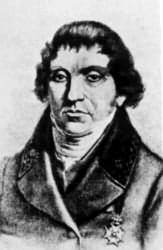
Georg (Göran) Wahlenberg was a Swedish naturalist. He was born in Kroppa, Värmland County.

The Teloschistales are an order of mostly lichen-forming fungi belonging to the class Lecanoromycetes in the division Ascomycota. According to one 2008 estimate, the order contains 5 families, 66 genera, and 1954 species. The predominant photobiont partners for the Teloschistales are green algae from the genera Trebouxia and Asterochloris.
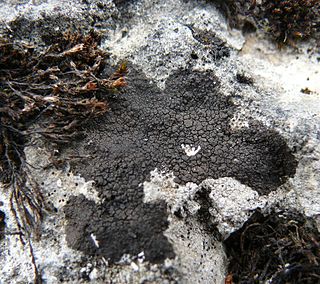
Verrucariaceae is a family of lichens and a few non-lichenised fungi in the order Verrucariales. The lichens have a wide variety of thallus forms, from crustose (crust-like) to foliose (bushy) and squamulose (scaly). Most of them grow on land, some in freshwater and a few in the sea. Many are free-living but there are some species that are parasites on other lichens, while one marine species always lives together with a leafy green alga.
Clavascidium is a genus of lichens in the family Verrucariaceae. The genus was circumscribed in 1996 by Austrian lichenologist Othmar Breuss. Because the type species of the genus, Clavascidium umbrinum, has been shown using molecular phylogenetics to belong to genus Placidium, Cécile Gueidan and colleagues proposed to unite Clavascidium with Placidium in a 2009 publication. Despite this, the genus has been retained in recent publications of fungal classification.
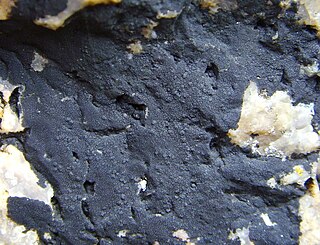
Hydropunctaria maura, still often called by the older name Verrucaria maura and commonly known as tar lichen, is a species of saxicolous (rock-dwelling), crustose lichen belonging to the family Verrucariaceae. A perennial species that does not experience seasonal variations, it is the type species of the genus Hydropunctaria. The medulla is a black basal layer that forms columns to the upper surface and isolates the algae into pockets near the upper surface. The black band formed by H. maura can often be seen at a distance as a marker of the high water point.

Hydropunctaria is a genus of saxicolous (rock-dwelling), crustose lichens in the family Verrucariaceae. The genus includes both aquatic and amphibious species, with members that colonise either marine or freshwater habitats. The type species, Hydropunctaria maura, was formerly classified in the large genus Verrucaria. It is a widely distributed species common to littoral zones. Including the type species, five Hydropunctaria lichens are considered marine species: H. adriatica, H. amphibia, H. aractina, H. orae, and H. oceanica.

Parabagliettoa is a genus of crustose lichens in the family Verrucariaceae. It has 3 species. The genus was circumscribed in 2009 by Cécile Gueidan and Claude Roux, with Parabagliettoa dufourii assigned as the type species.
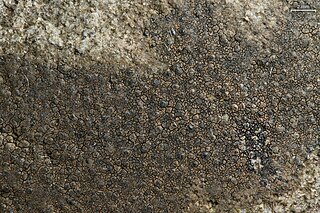
Willeya is a genus of saxicolous (rock-dwelling), crustose lichens in the family Verrucariaceae. It has 12 species. Most species are found in southeast Asia, although individual representatives are known from Australia, Europe, and North America.
Willeya australis is a species of saxicolous (rock-dwelling), crustose lichen in the family Verrucariaceae. Found in Indonesia, it was formally described as a new species in 1954 by Dutch lichenologist Pieter Groenhart, as Staurothele australis. He found the type specimen growing on rocks in the falls of the Brantas River. Although he included it in the genus Staurothele, he suggested that a placement in Willeya might also be appropriate. Cécile Gueidan made that generic transfer official in 2014 following molecular phylogenetic analysis of Staurothele and related genera in the Verrucariaceae.
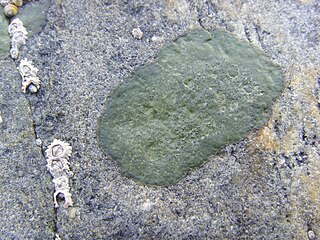
Wahlenbergiella is a genus of saxicolous (rock-dwelling), crustose lichens in the family Verrucariaceae. It has three species, all of which live in marine intertidal zones where they get periodically immersed in seawater. Wahlenbergiella closely resembles another lichen genus that includes marine species, Hydropunctaria. Wahlenbergiella was circumscribed in 2009 by Cécile Gueidan and Holger Thüs. They initially included two species: W. striatula, and the type, W. mucosa. The generic name honours Swedish naturalist Göran Wahlenberg, who originally described both of these species.

Mastodia is a genus of lichen-forming fungi in the family Verrucariaceae. It has six species.
Hydropunctaria rheitrophila is a species of freshwater, saxicolous (rock-dwelling), crustose lichen in the family Verrucariaceae. It was formally described as a new species in 1922 by German lichenologist Georg Hermann Zschacke as a species of Verrucaria. Christine Keller, Cécile Gueidan, and Holger Thüs transferred it to the newly circumscribed genus Hydropunctaria in 2009. It is one of several aquatic lichens that are in this genus. The photobiont partner of Hydropunctaria rheitrophila is a yellow-green alga.
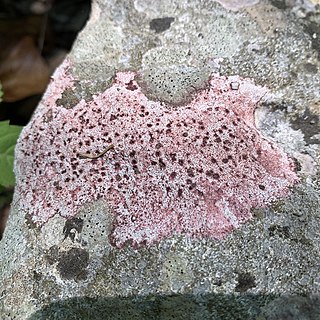
Bagliettoa marmorea is a species of saxicolous (rock-dwelling), crustose lichen in the family Verrucariaceae. It is endolithic on calcareous rocks, meaning it grows under and around the rock crystals. The colour of the lichen is purple to pink, although sometimes it is grey with purple pigments visible only around the perithecia. It does not have a shield-shaped involucrellum, which is typical of several other species in genus Bagliettoa. The excipulum measures 0.2–0.3 mm in diameter and lacks colour other than the upper part, which is purple. Ascospores are 13–30 by 9–15 μm.
Trimmatothele is a genus of saxicolous (rock-dwelling), crustose lichens in the family Verrucariaceae. It has five species. The genus was formally published by lichenologist Alexander Zahlbruckner in 1903. The type species, Trimmatothele perquisita, was originally collected from Norway by Johannes M. Norman, who placed it in the genus Coniothele in 1868. Diagnostic characteristics of Trimmatothele include a thin thallus with a smooth surface; small perithecia that are partially immersed in the substrata and have an involucrellum; asci that contain multiple ascospores; and small, simple ascospores. Trimmatothele has been described as one of the most poorly known genera of lichens due to the rarity of its species, the few available herbarium specimens, and some missing type specimens.
Wahlenbergiella tavaresiae is a species of saxicolous (rock-dwelling), crustose lichen in the family Verrucariaceae. Known from several locations in the San Francisco Bay area of the United States, it is a marine lichen that inhabits intertidal zones, and as such is immersed in seawater on a regular basis. Associated algal species include the red algae Hildenbrandia and Mastocarpus papillatus, and the brown algae Pelvetiopsis and Fucus. Petroderma maculiforme, a brown alga, is the photobiont partner in the lichen.
Claude Roux is a French lichenologist, mycologist and Esperantist. He has co-authored books about the identification of lichens written in Esperanto.
Cécile Gueidan is a mycologist and lichenologist who applies morphological and molecular biological methods to the origin and taxonomy of fungi that live in lichen symbioses and within rocks.

Staurothele pulvinata is a species of saxicolous (rock-dwelling), squamulose lichen in the family Verrucariaceae. The lichen was first formally described in 1861 by Theodor Magnus Fries, as a member of genus Endocarpon. The type specimen was collected from northern Norway. The taxon was later transferred to Dermatocarpon by Gustav Wilhelm Körber in 1863, and to Polyblastia by Antonio Jatta in 1900. Starri Heiðmarsson moved it to Staurothele in 2017, based on molecular phylogenetic analysis that showed it belonged to that genus. It is one of few squamulose species in a genus comprising mostly crustose lichens. Staurothele pulvinata has an arctic-alpine distribution; it has been recorded from Europe, Greenland, Iceland, and the United States.

Hydropunctaria amphibia is a species of saxicolous (rock-dwelling), crustose lichen in the family Verrucariaceae. One of several marine lichens in the genus Hydropunctaria, is widely distributed across Europe, extending from Norway to the Mediterranean and the Iberian coasts, and has a nearly ubiquitous presence along the Catalan coast of Spain. In North America, it is found along the Atlantic Coast from Nova Scotia to the Boston Harbor islands, where its presence in low-pollution areas indicates its potential as a bioindicator for marine lichen community health, and on the west coast in British Columbia, particularly in the Gwaii Haanas's upper littoral fringe. The black, crust-like thallus grows on seashore rocks – both siliceous rocks and limestone – in the lower supralittoral zone, an area also known as the splash zone. Originally described more than two centuries ago as a species of Verrucaria, Hydropunctaria amphibia sets itself apart from other species in Hydropunctaria through the distinct shape of the perithecium apex, which is either flat-topped or scalloped, in contrast to the typically rounded or immersed apex seen in its relatives.
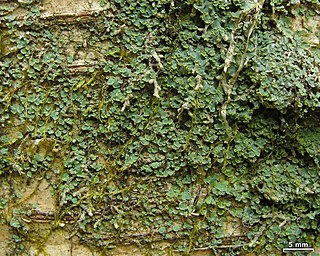
Normandina pulchella, commonly known as the elf-ear lichen or blue heart, is a species of squamulose lichen in the family Verrucariaceae. This cosmopolitan species is widely distributed across both hemispheres, where it thrives in moist microhabitats. It favours moss-covered deciduous trees and rocks, often colonising over mosses and bryophytes. It occasionally grows on bare bark and on other lichens. Distinctive features of N. pulchella include its bluish-green squamules (scales) with sharply raised margins, non-reactivity to standard chemical spot tests, and growth in humid habitats. Initially, Nannochloris normandinae, a green alga, was thought to be its photobiont. However, recent studies have revised this understanding, now suggesting Diplosphaera as the algal partner.













